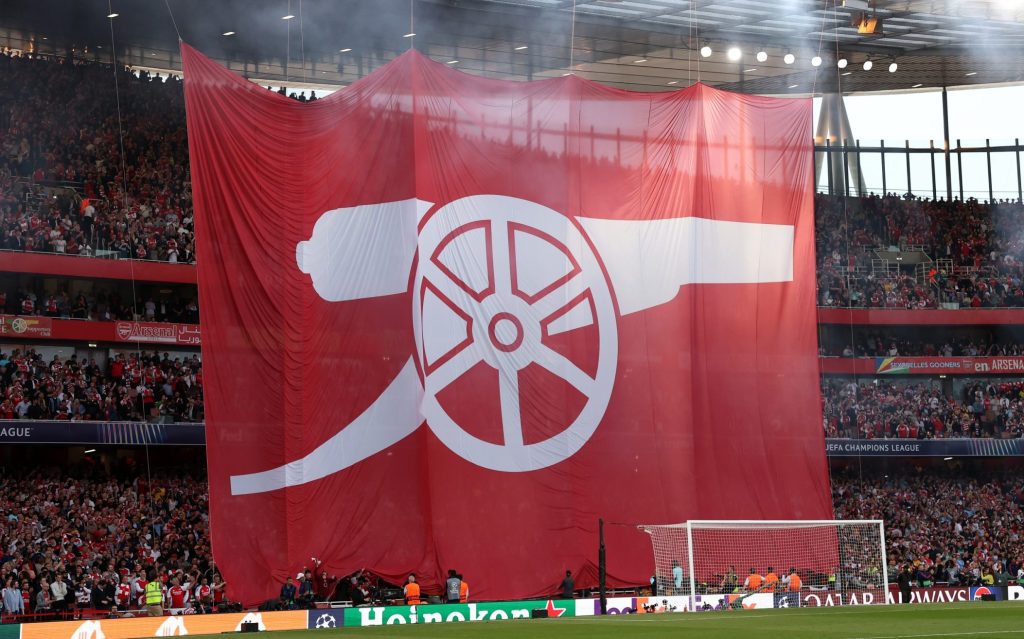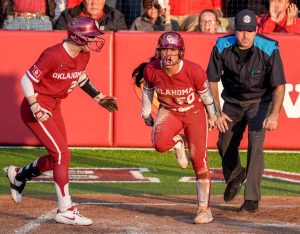
Special occasions call for special atmospheres and, before their Champions League semi-final against Paris St-Germain, Arsenal did all they could to create the most memorable night in the history of the Emirates Stadium.
There was the impassioned press conference by Mikel Arteta, who called on supporters to “bring your boots”. There was the pre-match hype video that declared it was “time to write our own history”. There was then a second video, of Arteta speaking directly to the camera, which represented the high point of his years-long campaign to weaponise the Emirates.
And, perhaps most eye-catchingly of all, there were the two enormous banners that were displayed inside the Emirates in the moments before kick-off. The first of those, featuring this season’s club catchphrase of “Make It Happen”, appeared near the halfway line. The second, showing Arsenal’s cannon emblem, was suspended from the roof of the North Bank.

Arsenal’s intention was clear: to whip the home crowd into a frenzy. On that front, they undoubtedly succeeded. At kick-off, it was perhaps the loudest the Emirates had ever been. Luis Enrique, the PSG manager, described it as “deafening”.
But then the actual football started. PSG scored after four minutes, and then barely surrendered possession for the next 20. It was a masterclass in drawing the sting from a home crowd. In the second half, too, the early setback of Mikel Merino’s disallowed goal had a damaging effect on the mood of the stadium.
By the time the Arsenal supporters were journeying home after the 1-0 defeat, much of their pre-match vigour had turned into post-game grumbles. The cannon tifo has since become the main source of irritation, with many fans complaining that it failed to have the desired effect. As ever, opposition supporters have been quick to mock, comparing the tifo unfavourably to the larger and bolder designs that are often seen at European arenas.
The Red Action supporters’ group went as far as saying the club “fumbled our biggest home game in 16 years”, adding that the roof banner was “a bit underwhelming”. The group had suggested alternative designs and imagery but those were rejected by the club, for timescale and production reasons.
“When it gets to this point in a season, folks with a degree in ‘brand management’ or ‘social media awareness’ should be in the background,” said Red Action in an online post. “Allow the actual fans with five, 10, 15, 20 years’ experience of following this club to set the temperature.”

At the other end of the stadium, another group of Arsenal supporters were also unhappy with the tifo situation. The controversial Ashburton Army, a group of black-shirted fans who have been trying in recent years to become the Arsenal equivalent of European ultras, had hoped to create a banner of their own.
In a statement that has since been deleted, the Ashburton Army said they had raised over £10,000 to fund a display for the PSG semi-final — but that the club had “declined our proposed design”.
Telegraph Sport understands that the issue was not necessarily the designs (which had a decidedly mixed response among supporters when they were revealed) but the timing of their proposal. The Ashburton Army, who were unusually subdued during the game, were simply too late.
Such matters are complicated further by the fact that Uefa effectively takes over control of the stadium in the days leading up to a Champions League match, and that there were less than two weeks between this game and the second-leg victory over Real Madrid. It should also be said that fan groups have been asking for a tifo in the North Bank for more than a decade, so it was hardly a case of the club suddenly deciding to thrust it upon the supporters.
Divisions in fanbase
It is a reality of Arsenal’s present situation that, for all the progress made at the Emirates, it feels like grievances are always bubbling close to the surface. Thanks to Arteta’s rebuild and encouragement, the home crowd is generally more loud and supportive now than it has been for the vast majority of the stadium’s existence – but there remains a hum of underlying concerns.
This can be explained, in part, by divisions within the fanbase. Many long-serving supporters object to the club’s new pre-match anthem, The Angel, for example, while there are plenty of younger fans who love it. The Ashburton Army, too, are regarded by some younger supporters as pivotal to the atmosphere in the ground. But many others find them embarrassing, if not downright offensive. The club have previously liaised with the police over alleged antisemitism within the group.

Separately to these issues, there has been disgruntlement in recent years at the club’s new ticket ballot system. And, as with so many Premier League clubs, regular rises in ticket prices have not helped to create a sense of harmony between the institution and its supporters. In March, the Arsenal Supporters’ Trust said it was “extremely disappointed” after the club increased season ticket prices for the 2025-26 campaign.
Such has been the progress of Arteta’s team on the pitch in recent years, these issues have almost become entirely separated from the support for the players at home games. Arsenal’s fans may not love all of the club’s policies – or, indeed, their choice of tifo design on Tuesday night – but they do seem to love the team more than at any point in the past decade.
The problem is that the concerns are never far from the surface, and it therefore does not take much for them to boil over. In this case, an unspectacular tifo and a disappointing team performance contributed to much of the enthusiasm draining from the Emirates long before the end of the game. At Arsenal, where the club and supporters so desperately crave success, it does not take much for the balloon to pop. That might not change until Arsenal achieve their ultimate goal: winning major trophies again.

Special occasions call for special atmospheres and, before their Champions League semi-final against Paris St-Germain, Arsenal did all they could to create the most memorable night in the history of the Emirates Stadium.
There was the impassioned press conference by Mikel Arteta, who called on supporters to “bring your boots”. There was the pre-match hype video that declared it was “time to write our own history”. There was then a second video, of Arteta speaking directly to the camera, which represented the high point of his years-long campaign to weaponise the Emirates.
And, perhaps most eye-catchingly of all, there were the two enormous banners that were displayed inside the Emirates in the moments before kick-off. The first of those, featuring this season’s club catchphrase of “Make It Happen”, appeared near the halfway line. The second, showing Arsenal’s cannon emblem, was suspended from the roof of the North Bank.

Arsenal’s intention was clear: to whip the home crowd into a frenzy. On that front, they undoubtedly succeeded. At kick-off, it was perhaps the loudest the Emirates had ever been. Luis Enrique, the PSG manager, described it as “deafening”.
But then the actual football started. PSG scored after four minutes, and then barely surrendered possession for the next 20. It was a masterclass in drawing the sting from a home crowd. In the second half, too, the early setback of Mikel Merino’s disallowed goal had a damaging effect on the mood of the stadium.
By the time the Arsenal supporters were journeying home after the 1-0 defeat, much of their pre-match vigour had turned into post-game grumbles. The cannon tifo has since become the main source of irritation, with many fans complaining that it failed to have the desired effect. As ever, opposition supporters have been quick to mock, comparing the tifo unfavourably to the larger and bolder designs that are often seen at European arenas.
The Red Action supporters’ group went as far as saying the club “fumbled our biggest home game in 16 years”, adding that the roof banner was “a bit underwhelming”. The group had suggested alternative designs and imagery but those were rejected by the club, for timescale and production reasons.
“When it gets to this point in a season, folks with a degree in ‘brand management’ or ‘social media awareness’ should be in the background,” said Red Action in an online post. “Allow the actual fans with five, 10, 15, 20 years’ experience of following this club to set the temperature.”

At the other end of the stadium, another group of Arsenal supporters were also unhappy with the tifo situation. The controversial Ashburton Army, a group of black-shirted fans who have been trying in recent years to become the Arsenal equivalent of European ultras, had hoped to create a banner of their own.
In a statement that has since been deleted, the Ashburton Army said they had raised over £10,000 to fund a display for the PSG semi-final — but that the club had “declined our proposed design”.
Telegraph Sport understands that the issue was not necessarily the designs (which had a decidedly mixed response among supporters when they were revealed) but the timing of their proposal. The Ashburton Army, who were unusually subdued during the game, were simply too late.
Such matters are complicated further by the fact that Uefa effectively takes over control of the stadium in the days leading up to a Champions League match, and that there were less than two weeks between this game and the second-leg victory over Real Madrid. It should also be said that fan groups have been asking for a tifo in the North Bank for more than a decade, so it was hardly a case of the club suddenly deciding to thrust it upon the supporters.
Divisions in fanbase
It is a reality of Arsenal’s present situation that, for all the progress made at the Emirates, it feels like grievances are always bubbling close to the surface. Thanks to Arteta’s rebuild and encouragement, the home crowd is generally more loud and supportive now than it has been for the vast majority of the stadium’s existence – but there remains a hum of underlying concerns.
This can be explained, in part, by divisions within the fanbase. Many long-serving supporters object to the club’s new pre-match anthem, The Angel, for example, while there are plenty of younger fans who love it. The Ashburton Army, too, are regarded by some younger supporters as pivotal to the atmosphere in the ground. But many others find them embarrassing, if not downright offensive. The club have previously liaised with the police over alleged antisemitism within the group.

Separately to these issues, there has been disgruntlement in recent years at the club’s new ticket ballot system. And, as with so many Premier League clubs, regular rises in ticket prices have not helped to create a sense of harmony between the institution and its supporters. In March, the Arsenal Supporters’ Trust said it was “extremely disappointed” after the club increased season ticket prices for the 2025-26 campaign.
Such has been the progress of Arteta’s team on the pitch in recent years, these issues have almost become entirely separated from the support for the players at home games. Arsenal’s fans may not love all of the club’s policies – or, indeed, their choice of tifo design on Tuesday night – but they do seem to love the team more than at any point in the past decade.
The problem is that the concerns are never far from the surface, and it therefore does not take much for them to boil over. In this case, an unspectacular tifo and a disappointing team performance contributed to much of the enthusiasm draining from the Emirates long before the end of the game. At Arsenal, where the club and supporters so desperately crave success, it does not take much for the balloon to pop. That might not change until Arsenal achieve their ultimate goal: winning major trophies again.










